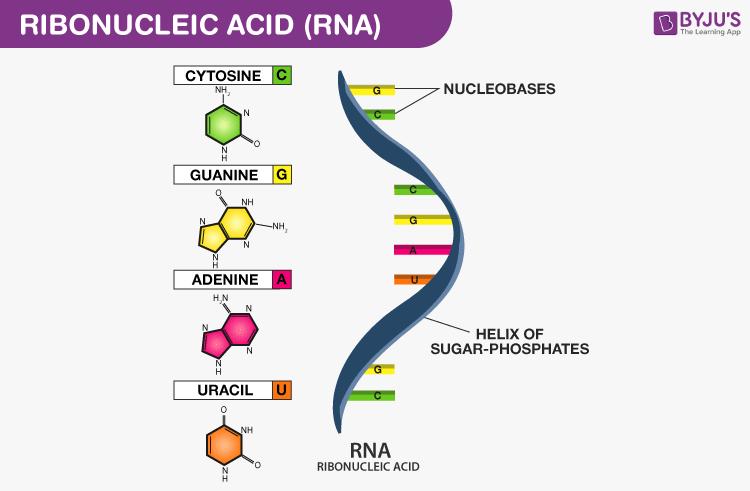RNA is a ribonucleic acid that helps in the synthesis of proteins in our body. This nucleic acid is responsible for the production of new cells in the human body. It is usually obtained from the DNA molecule. RNA resembles the same as that of DNA, the only difference being that it has a single strand unlike the DNA which has two strands and it consists of an only single ribose sugar molecule in it. Hence is the name Ribonucleic acid. RNA is also referred to as an enzyme as it helps in the process of chemical reactions in the body.

Basic Structure of RNA
The basic structure of RNA is shown in the figure below-
The ribonucleic acid has all the components same to that of the DNA with only 2 main differences within it. RNA has the same nitrogen bases called the adenine, Guanine, Cytosine as that of the DNA except for the Thymine which is replaced by the uracil. Adenine and uracil are considered as the major building blocks of RNA and both of them form base-pair with the help of 2 hydrogen bonds.
RNA resembles a hairpin structure and like the nucleotides in DNA, nucleotides are formed in this ribonucleic material(RNA). Nucleosides are nothing but the phosphate groups which sometimes also helps in the production of nucleotides in the DNA.

Also refer: RNA World – The Genetic Material
Functions of RNA
The ribonucleic acid – RNA, which are mainly composed of nucleic acids, are involved in a variety of functions within the cell and are found in all living organisms including bacteria, viruses, plants, and animals. These nucleic acid functions as a structural molecule in cell organelles and are also involved in the catalysis of biochemical reactions. The different types of RNA are involved in various cellular process. The primary functions of RNA:
- Facilitate the translation of DNA into proteins
- Functions as an adapter molecule in protein synthesis
- Serves as a messenger between the DNA and the ribosomes.
- They are the carrier of genetic information in all living cells
- Promotes the ribosomes to choose the right amino acid which is required in building up of new proteins in the body.
Also Read: Difference between deoxyribose and ribose
RNA Types
There are various types of RNA, out which most well-known and most commonly studied in the human body are :
- tRNA – Transfer RNA
The transfer RNA is held responsible for choosing the correct protein or the amino acids required by the body in-turn helping the ribosomes. It is located at the endpoints of each amino acid. This is also called as soluble RNA and it forms a link between the messenger RNA and the amino acid.
- rRNA-Ribosomal RNA
The rRNA is the component of the ribosome and are located within the in the cytoplasm of a cell, where ribosomes are found. In all living cells, the ribosomal RNA plays a fundamental role in the synthesis and translation of mRNA into proteins. The rRNA is mainly composed of cellular RNA and are the most predominant RNA within the cells of all living beings.
- mRNA – Messenger RNA.
This type of RNA functions by transferring the genetic material into the ribosomes and pass the instructions about the type of proteins, required by the body cells. Based on the functions, these types of RNA is called the messenger RNA. Therefore, the mRNA plays a vital role in the process of transcription or during the protein synthesis process.
Also read: Process of Protein Synthesis
Learn more about RNA, its structure, functions, types and other related topics @ BYJU’S Biology

So good
thank you, very helpful n easily understood 👌👌👌
Much useful for rapid revision 👍
Thank you.